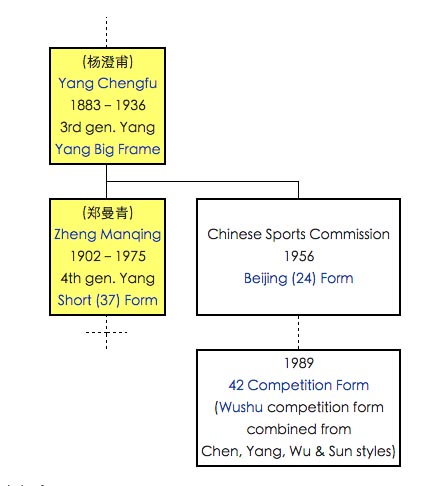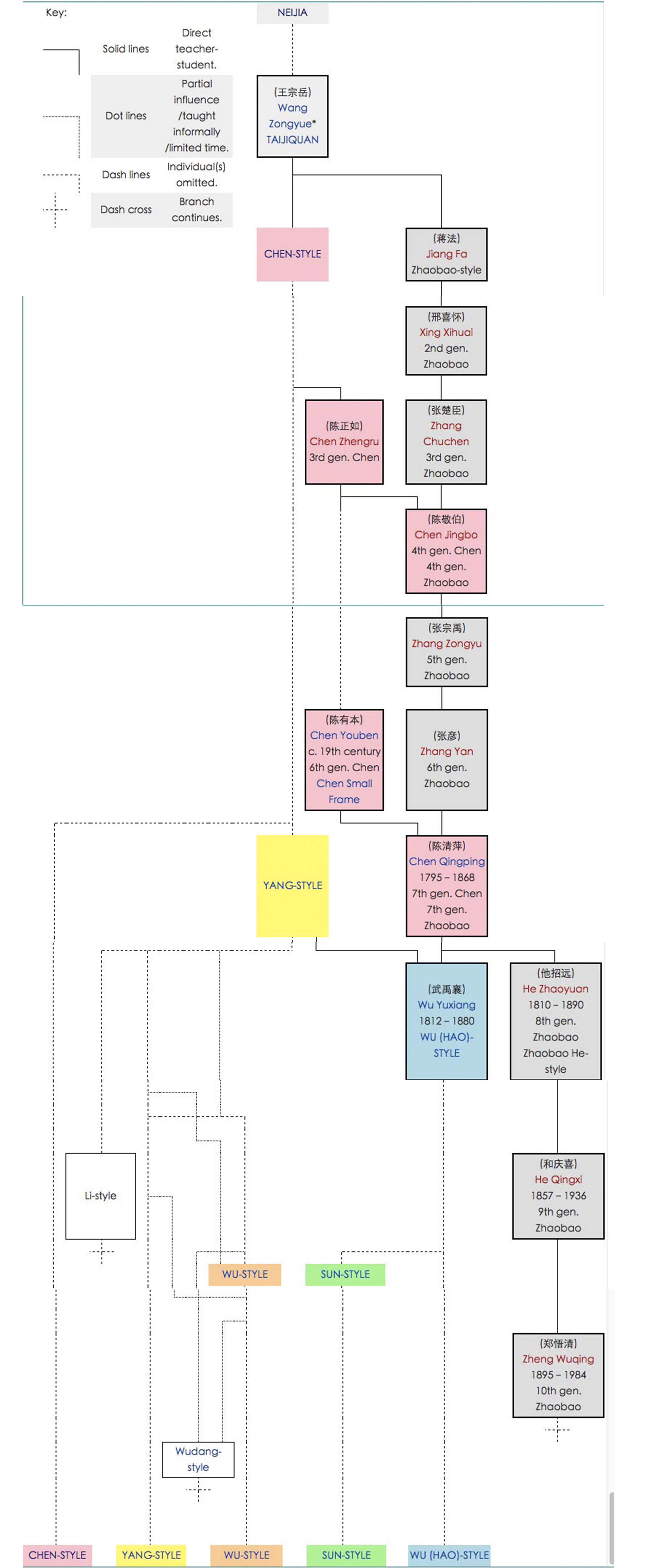Category: Research
Research-concret anchor
Research-playground-Material
Anodized Aluminum
Anodized aluminum creates cool, kid-friendly climbs. The panels on our Mobius® climbers are made of recycled, textured, anodized aluminum. This rust-free surface refracts sunlight for a comfortable climb all summer long and is virtually maintenance free. And it’s grippy, so it helps kids maneuver safely through their loopiest climbs. Panels in cool silver; steel supports in any ProShield® color.
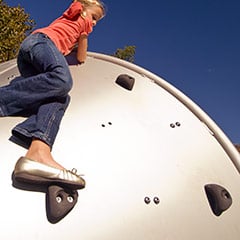
CableCore® Material
CableCore® material is tough, gentle and made to last for years. Unlike traditional ropes that can rub skin the wrong way, our CableCore material has a durable, UV-stabilized, easy-on-the-hands polyurethane coating surrounding a super-strong, aircraft-grade, galvanized-steel core. Our exclusive material won’t deteriorate or fray, become too hot in the summer or cold in the winter. And its gentle ridges provide a soft, sturdy surface kids can latch onto for climbing or hand-over-hand swinging. And with its thoughtful engineering, it can go for a generations without replacement! U.S. Patent #6,475,117

Concrete
We use Glass Fiber Reinforced Concrete (GFRC) and wet-cast concrete to create specific concrete products. We spray GFRC into molds to create larger scale panels with intricate surface detail. GFRC can also be hand-sculpted onto steel frames, which we use to create more sculptural elements like 3D figures, animals and highly customized designs. We use wet-cast concrete to mold solid objects with precise detail.
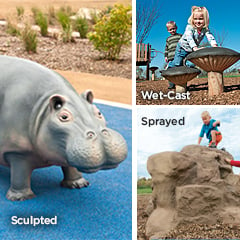
CoolToppers Fabric
CoolToppers® are designed to protect kids from up to 90 percent of the sun’s harmful UV rays and keep playground temperatures up to 30 degrees cooler. It’s also flame retardant and resistant to mildew, fading and ultraviolet rays, making it a long-lasting, great looking addition to your playground. Available in seven colors shown, and custom colors for an additional charge.

Galvanized Steel
We only use galvanized steel for maximum durability. All galvanized steel parts are ProShield® finished for optimum corrosion resistance, UV stability and gloss retention.
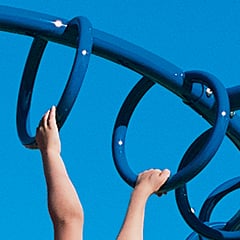
GripX
GripX is a UV stabilized HDPE (high-density polyethylene), marine-grade material. Specially designed slip resistant texture enhances traction and appearance. Easy to clean and endures harsh climate conditions.
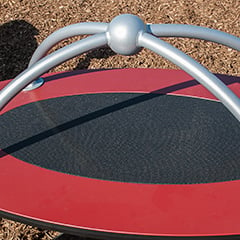
Permalene® Material
Permalene® panels look like new year after year. In 1985, Landscape Structures introduced Permalene material to the marketplace in kid-friendly activity panels. Today, we use this strong 3/4”-thick, customized material for interactive play panels, tables, handholds and signs. The distinctive black core in these 73 percent post-consumer recycled panels is the result of combining and recycling colored plastic household containers.
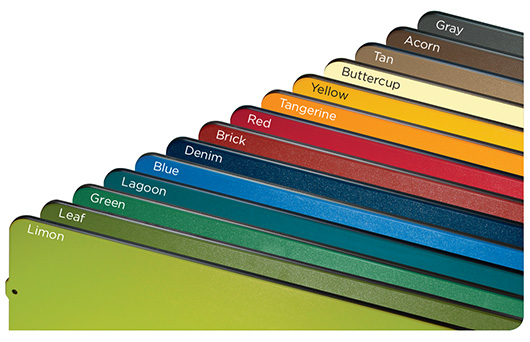
ProGuard™ Finish
Difference you can see! ProGuard is a new super-resistant finish now applied standard to all Landscape Structures swing chain that’s at least two times more corrosion resistant than galvanized steel chain.
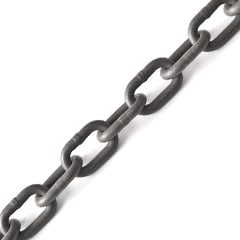
ProShield® Finish
ProShield® finish is a smart combination of beauty and brawn. Our ProShield finish is so tough, it substantially increases the durability of our products. We’ve combined a specially formulated primer with a high-quality, architectural-grade powdercoat topcoat. The result is enhanced longevity, greater protection against harsh UV rays, prevention from corrosion and improved product performance. You’ll first notice the vibrant, long-lasting color and glossier finish. You’ll appreciate the fact that something so attractive also reduces corrosion and chipping, requiring less maintenance. It’s available in all the great colors you’ve come to love. And we reclaim our epoxy primer within the process, eliminating waste powder.
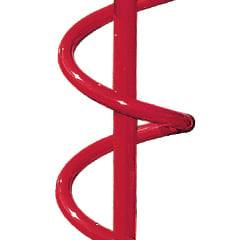
Recycled Planks
Looks like wood, but lasts longer and are easier to clean. Created from 100% post-consumer high-density UV-stabilized polyethylene material to prevent warping in direct sun. Thickness of material varies by individual product.

Rotationally-Molded Polyethylene
The heavy-duty rotationally molded polyethylene material ensures strength and durability while resisting cracking, fading and peeling. Components constructed of durable double-walled polyethylene have built-in safety and are easy to install.
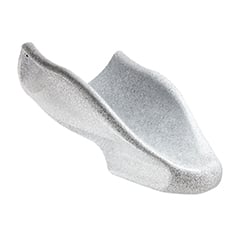
Steel-Reinforced Climbing Cables Powered by Berliner
Steel-reinforced cables provide years of safe, bouncy fun. Made of tightly woven, polyester-wrapped, six-stranded galvanized-steel cable. These abrasion-resistant, color-stable cables are extremely durable and vandal resistant. Powered by Berliner Seilfabrik, one of the most experienced manufacturers of steel cables in the world, with a global reputation for top quality since 1865.

TenderTuff™ Coating
For swing chains, handholds, pipe barriers, wheels, rings, etc. Available in Red, Tan, Blue, Brown and Gray. Insulates against temperature extremes and provides a safer grip surface compared to painted metal. TenderTuff meets all safety standards and complies with Public Law No. 110-314, Consumer Product Safety Improvement Act of 2008.
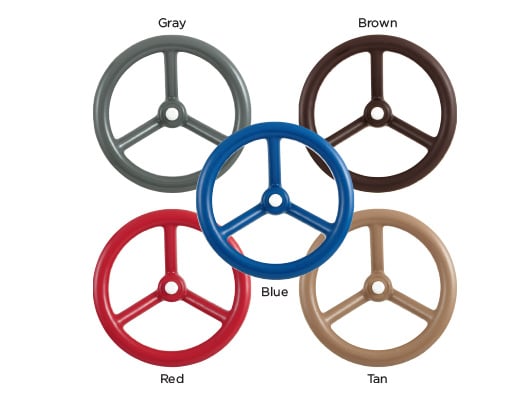
Textured-Polyester Resin Handgrips and Footholds
Durable, easy-to-grasp handgrips and footholds made of low-density, UV-stable polyester resin. Large enough to ensure secure grips, feels just like the climbing gym.
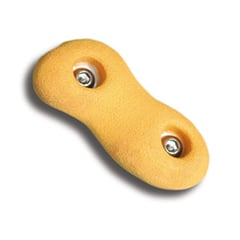
Source: https://www.playlsi.com/en/our-story/top-quality-and-service/materials-matter/materials-matter
Research-floor material/method
Wet pour rubber is the EPDM (Ethylene Propylene Diene Modified) rubber granules that form the basis of wet pour playground safety surfacing. Other fixed play surfaces such as Notts Sport Childsplay are polypropylene, but some ChildsPlay systems do incorporate the use of rubber crumb.
The majority of black, wet pour playground surfaces are made from recycled car tyres. This is a positive step, as disposing of old car tyres has always been difficult and had adverse environmental impacts.
There is both a mechanical and chemical method for reclaiming the materials that the rubber granules are made from:
- The mechanical method involves cutting the tyres into pieces and passing them through a mechanical grinder. A number of passes are required in order for the tyres to be cut down into small enough pieces to make them workable when they are laid as wetpour playground safety flooring. Following this, large magnets remove any metal contaminants from the rubber crumb.
- The chemical method involves the tyres being melted over metal gauze. The molten rubber is allowed to pass through the gauze and into cold water. The temperature change caused by the water rapidly cooling the molten rubber, makes the rubber form into granules. The size of the rubber granules is determined by the size/gauge of the gauze used.
Different sizes of wetpour rubber are used for different applications. For instance the smallest granules (1-2 mm is this correct) are used in the Notts Sport Childsplay 90/120 system, where as medium sized granules (1-4mm) are used in the wearing course of wetpour rubber. The largest sized granules (2-8mm) are used in the base course of wet pour safety surfacing.
Initially rubber crumb was resin bound in pre-cast tiles, which were a common form of playground surfacing. Although it was easier to install, it was very susceptible to vandalism and ultimately ended up costing local authorities/parish councils too much to maintain. Hence one piece, poured wet pour was created. Look at the wet pour page for further information.
Groundwork and Leisure Services (GLS) offer a nationwide installation service for wet pour play area surfacing. Many councils are however, opting to install Notts Sport ChildsPlay system, as they offer all the benefits of wet pour with a higher level of vandalism resistance and therefore longevity. GLS therefore encourage would be clients to consider Notts Sport as potentially the best playground surface on the market.
Monolith Illustrations by Fabrice Le Nezet
Monolith, a series of poster illustrations inspired by architecture and kids playgrounds.
Fabrice Le Nezet is a London, United Kingdom based designer, visual artist, and filmmaker. You may remember some of our previous features of Fabrice Le Nezet‘s projects. His creative work draws inspiration from diverse genres such as architecture, fashion, and toys. Today it’s time to show you more of his outstanding design.
This series of prints is called “Monolith”. The collection of 10 illustrations explores the intersection between architecture and kids playgrounds. You can get each work as Gyclee print on Hahnemuhle photorag paper in the size of 25cm x 35cm.
Is Sitting a Lethal Activity?
DR. LEVINE’S MAGIC UNDERWEAR resembled bicycle shorts, black and skintight, but with sensors mounted on the thighs and wires running to a fanny pack. The look was part Euro tourist, part cyborg. Twice a second, 24 hours a day, the magic underwear’s accelerometers and inclinometers would assess every movement I made, however small, and whether I was lying, walking, standing or sitting.
James Levine, a researcher at the Mayo Clinic in Rochester, Minn., has an intense interest in how much people move — and how much they don’t. He is a leader of an emerging field that some call inactivity studies, which has challenged long-held beliefs about human health and obesity. To help me understand some of the key findings, he suggested that I become a mock research trial participant. First my body fat was measured inside a white, futuristic capsule called a Bod Pod. Next, one of Dr. Levine’s colleagues, Shelly McCrady-Spitzer, placed a hooded mask over my head to measure the content of my exhalations and gauge my body’s calorie-burning rate. After that, I donned the magic underwear, then went down the hall to the laboratory’s research kitchen for a breakfast whose calories were measured precisely.
A weakness of traditional activity and obesity research is that it relies on self-reporting — people’s flawed recollections of how much they ate or exercised. But the participants in a series of studies that Dr. Levine did beginning in 2005 were assessed and wired up the way I was; they consumed all of their food in the lab for two months and were told not to exercise. With nary a snack nor workout left to chance, Dr. Levine was able to plumb the mysteries of a closed metabolic universe in which every calorie, consumed as food or expended for energy, could be accounted for.
His initial question — which he first posed in a 1999 study — was simple: Why do some people who consume the same amount of food as others gain more weight? After assessing how much food each of his subjects needed to maintain their current weight, Dr. Levine then began to ply them with an extra 1,000 calories per day. Sure enough, some of his subjects packed on the pounds, while others gained little to no weight.
“We measured everything, thinking we were going to find some magic metabolic factor that would explain why some people didn’t gain weight,” explains Dr. Michael Jensen, a Mayo Clinic researcher who collaborated with Dr. Levine on the studies. But that wasn’t the case. Then six years later, with the help of the motion-tracking underwear, they discovered the answer. “The people who didn’t gain weight were unconsciously moving around more,” Dr. Jensen says. They hadn’t started exercising more — that was prohibited by the study. Their bodies simply responded naturally by making more little movements than they had before the overfeeding began, like taking the stairs, trotting down the hall to the office water cooler, bustling about with chores at home or simply fidgeting. On average, the subjects who gained weight sat two hours more per day than those who hadn’t.
People don’t need the experts to tell them that sitting around too much could give them a sore back or a spare tire. The conventional wisdom, though, is that if you watch your diet and get aerobic exercise at least a few times a week, you’ll effectively offset your sedentary time. A growing body of inactivity research, however, suggests that this advice makes scarcely more sense than the notion that you could counter a pack-a-day smoking habit by jogging. “Exercise is not a perfect antidote for sitting,” says Marc Hamilton, an inactivity researcher at the Pennington Biomedical Research Center.
The posture of sitting itself probably isn’t worse than any other type of daytime physical inactivity, like lying on the couch watching “Wheel of Fortune.” But for most of us, when we’re awake and not moving, we’re sitting. This is your body on chairs: Electrical activity in the muscles drops — “the muscles go as silent as those of a dead horse,” Hamilton says — leading to a cascade of harmful metabolic effects. Your calorie-burning rate immediately plunges to about one per minute, a third of what it would be if you got up and walked. Insulin effectiveness drops within a single day, and the risk of developing Type 2 diabetes rises. So does the risk of being obese. The enzymes responsible for breaking down lipids and triglycerides — for “vacuuming up fat out of the bloodstream,” as Hamilton puts it — plunge, which in turn causes the levels of good (HDL) cholesterol to fall.

Hamilton’s most recent work has examined how rapidly inactivity can cause harm. In studies of rats who were forced to be inactive, for example, he discovered that the leg muscles responsible for standing almost immediately lost more than 75 percent of their ability to remove harmful lipo-proteins from the blood. To show that the ill effects of sitting could have a rapid onset in humans too, Hamilton recruited 14 young, fit and thin volunteers and recorded a 40 percent reduction in insulin’s ability to uptake glucose in the subjects — after 24 hours of being sedentary.
Over a lifetime, the unhealthful effects of sitting add up. Alpa Patel, an epidemiologist at the American Cancer Society, tracked the health of 123,000 Americans between 1992 and 2006. The men in the study who spent six hours or more per day of their leisure time sitting had an overall death rate that was about 20 percent higher than the men who sat for three hours or less. The death rate for women who sat for more than six hours a day was about 40 percent higher. Patel estimates that on average, people who sit too much shave a few years off of their lives.
Another study, published last year in the journal Circulation, looked at nearly 9,000 Australians and found that for each additional hour of television a person sat and watched per day, the risk of dying rose by 11 percent. The study author David Dunstan wanted to analyze whether the people who sat watching television had other unhealthful habits that caused them to die sooner. But after crunching the numbers, he reported that “age, sex, education, smoking, hypertension, waist circumference, body-mass index, glucose tolerance status and leisure-time exercise did not significantly modify the associations between television viewing and all-cause . . . mortality.”
Sitting, it would seem, is an independent pathology. Being sedentary for nine hours a day at the office is bad for your health whether you go home and watch television afterward or hit the gym. It is bad whether you are morbidly obese or marathon-runner thin. “Excessive sitting,” Dr. Levine says, “is a lethal activity.”
The good news is that inactivity’s peril can be countered. Working late one night at 3 a.m., Dr. Levine coined a name for the concept of reaping major benefits through thousands of minor movements each day: NEAT, which stands for Non-Exercise Activity Thermogenesis. In the world of NEAT, even the littlest stuff matters. McCrady-Spitzer showed me a chart that tracked my calorie-burning rate with zigzagging lines, like those of a seismograph. “What’s that?” I asked, pointing to one of the spikes, which indicated that the rate had shot up. “That’s when you bent over to tie your shoes,” she said. “It took your body more energy than just sitting still.”
In a motion-tracking study, Dr. Levine found that obese subjects averaged only 1,500 daily movements and nearly 600 minutes sitting. In my trial with the magic underwear, I came out looking somewhat better — 2,234 individual movements and 367 minutes sitting. But I was still nowhere near the farm workers Dr. Levine has studied in Jamaica, who average 5,000 daily movements and only 300 minutes sitting.
Dr. Levine knows that we can’t all be farmers, so instead he is exploring ways for people to redesign their environments so that they encourage more movement. We visited a chairless first-grade classroom where the students spent part of each day crawling along mats labeled with vocabulary words and jumping between platforms while reciting math problems. We stopped by a human-resources staffing agency where many of the employees worked on the move at treadmill desks — a creation of Dr. Levine’s, later sold by a company called Steelcase.
Dr. Levine was in a philosophical mood as we left the temp agency. For all of the hard science against sitting, he admits that his campaign against what he calls “the chair-based lifestyle” is not limited to simply a quest for better physical health. His is a war against inertia itself, which he believes sickens more than just our body. “Go into cubeland in a tightly controlled corporate environment and you immediately sense that there is a malaise about being tied behind a computer screen seated all day,” he said. “The soul of the nation is sapped, and now it’s time for the soul of the nation to rise.”
Non-exercise activity Thermogenesis- N.E.A.T
The N.E.A.T. Way to Exercise
February 27, 2014
Most people think that the only way to burn calories is through scheduled exercise sessions. Although exercise is the most ideal way to expend a lot of calories, there are additional ways to burn them throughout the day that are not programmed sessions. Both weight loss and weight maintenance can be made easier with a clear understanding of non-exercise activity thermogenesis, or N.E.A.T.
Non-exercise activity thermogenesis includes the calories expended outside of exercise, eating and sleeping. There are many N.E.A.T. activities that we already do, but may not realize its caloric output effect. Simple tasks such as raking leaves, physical labor, climbing stairs and even fidgeting help us expend additional calories. In essence, N.E.A.T. increases metabolic rate and results in a substantial energy cost overtime.
Recent movement findings were discussed in the ACE webinar, “Consequences of Sitting and How to Become a Movement Warrior.” Research suggests that individuals who move throughout the day are more likely to reach or maintain weight-loss goals versus those who are sedentary throughout the day and vigorously move through one exercise session. Therefore, a greater caloric output occurs throughout the day rather than during one vigorous exercise session. Researcher James Levine, M.D., who has published several journal articles on the positive effects of N.E.A.T., found that adopting N.E.A.T. behaviors can increase daily caloric expenditure by as much as 350 calories per day, and is particularly beneficial for obese individuals.
Most people spend the majority of their day at work. One way to increase caloric burn is to implement non-exercise movement throughout the workday. Agriculture, construction and housekeeping trades are good examples of high N.E.A.T. jobs because they require a high demand for movement. On the other hand, desk jobs are primarily sedentary and do not expend much energy cost. So how can you increase your N.E.A.T. during the workday? Here are some creative ideas to integrate movement:
Change your mode of transportation. Walk, bike or bus to work instead of driving. This starts and ends the day on a good note, along with a breath of fresh air.
Implement walking meetings. Head outdoors and boost your team’s creativity with a walking meeting. Walking is an effective way to burn calories, stimulate the brain and bond the team.
Throw out your garbage can. Give your eyes and body a break from the computer screen by removing your garbage can from under your desk. This gives you a reason to get up and walk to the workroom or break room to throw out your trash or recycling materials.
Create wellness challenges. Talk to your HR or Wellness department about creating walking challenges. If HR cannot help, form walking teams within your department. One challenge may include walking 10,000 steps per day for 10 days. Individuals who meet or exceed the goal’s challenge can win a prize or an incentive reward. Pedometers and Fitbit devices are beneficial tools to track these steps.
Take the stairs. This old adage still rings true. Skip the elevator and take the stairs to keep the body moving throughout the day.
Stand instead of sit. Adjustable and treadmill desks are becoming increasingly popular in the workplace. However, if these desks are not available, raise your work to a podium or counter so you can stand throughout the day. This is advantageous for those who need to read or work from a laptop or mobile device. Resting heart rate is higher while standing than sitting, thus increasing caloric output.
Accumulated physical activity can significantly increase the number of calories burned throughout the day or week. Therefore, if you’re tied behind the desk remember there are plenty of ways to incorporate movement when you cannot formally exercise. Other N.E.A.T. examples include:
- Playing with your kids
- Completing yard work
- Grocery shopping
- Walking the dog
- Cleaning the house
If your day lacks N.E.A.T., think of one or two ideas that you can start with to integrate movement into your day or week. For those who track calories, use www.myfitnesspal.com to find an estimated calorie burn based on the activity, length of time and current weight. This site, along with other websites, does not consider gender, which does affect the caloric output. However, it is an effective guide for calculating caloric burn, especially for activities such as chores or yard work. Myfitnesspal.com is free and easy to use for those who do not have a current calorie tracker device or website.
So the next time you’re looking to rev up your calorie burn, choose the N.E.A.T. way to stay active. N.E.A.T. is a beneficial addition to your exercise routine that does not take time away from home or family—perfect for those who find time is their worst enemy.
source: https://www.acefitness.org/acefit/healthy-living-article/60/3757/the-n-e-a-t-way-to-exercise/
Taichi CHI
Taichi Ball rotation exercise
Taichi style tree – ( why I choose 24 forms of yang style)
1. How did Tai Chi begin?
There are two theories
- Theory #1
- Around the Yuan and Ming Dynasty – Chang Sanfeng – about 600-700 years ago lived in Shaolin Temple and went to WuDang Mountain and created Tai Chi. He saw a crane fighting with a snake. The crane was always hard. The snake would yield and follow the crane and did not resist and so he didn’t lose his life to the crane. Hard was controlled by soft.
- Theory #2
- Created by Chen Family about 300 years ago by Chen Wangting.
2. What are the 13 Postures (original name of Tai Chi Chuan)?
The 13 Postures are comprised of 8 energies and 5 steps:
8 energies are: ward off, roll back, press, push, pull, elbow strike, shoulder strike, and split
5 steps are: forward, back, look left, gaze right, and center
3. How many styles of Tai Chi are there and what are their differences?
There are 5 different styles of Tai Chi that are connected with each other. Chen, Yang, Wu, Wu and Sun styles. All 5 styles are connected together; their outside movements are a little different but inside the energies are the same.
Chen Style – is fast and slow combined together with some jumping and stomping movements. Old form and cannon fist was created from the 17th generation.
Yang Style – Yang Luchan learned the old form/frame from the Chen family. Yang movements are slow, even, gentle, big and large. Yang Luchan learned from the 14th generation Chen family member.
Wu/Hao Style – The 1st Wu style came from Yang and Chen styles and is slow, smooth, and small and the posture is high. Wu Yuxiang learned from Yang Banhou, 2nd generation Yang family member, and then learned from Chen Qingping, 14th generation. Wu/Hao is a smaller frame.
Wu Style – 2nd Wu style comes from Quanyu who learned from Yang Banhou. They lean their body to the side but when they lean they think about being straight. Wu learned from Yang Banhou. Later in age Banhou’s frame became smaller.
Sun Style – learned from Hao Weijian. Their movements combine 3 styles of Tai Chi together, Wu, Hsing-I and Bagua.
4. Who created each of the 5 styles?
Chen was created by Chen Wangting
Yang was created by Yang Luchan
Wu/Hao was created by Wu Yuxiang
Wu was created by Wu Jian Quan or Wu Quanyu
Sun was created by Sun Lutang
5. Who did the creators learn from?
Yang Luchan learned from Chen Changxin
Wu Yuxiang learned from Yang Luchan, Yang Banhou and Chen Qingping
Wu Jianquan learned from his father, Quanyu
Sun Lutang learned from Hao Weijian
6. The most practised form now.
The Beijing 24 Form was the result of an effort by the Chinese Sports Committee, which, in 1956, brought together four Taiji teachers – Chu Guiting, Cai Longyun, Fu Zhongwen, and Zhang Yu – to create a simplified form of Taiji as exercise for the masses. The creators truncated the traditional family style Taiji forms to 24 postures; taking about six minutes to perform and to give the beginner an introduction to the essential elements of Taijiquan, yet retain the traditional flavor of traditional longer hand forms (in general, 88-108 postures). Henceforth, this form was avidly promoted by the People’s Republic of China for general exercise, and was also taught to internees in Communist “re-education” camps. Due to this official promotion, the 24-form is most likely the Taiji form with the most practitioners in China and the world over.
source:
https://en.wikipedia.org/wiki/Yang-style_t%27ai_chi_ch%27uan
https://en.wikipedia.org/wiki/24-form_tai_chi_chuan
http://www.yangfamilytaichi.com/about/study/#history-01

